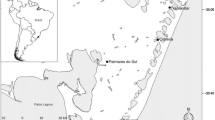Abstract
Ghylls are linear valley features cut into the sandy beds of the Weald of south-eastern England. The ghyll's indigenous woodlands are highly species rich at the small scale, support distinctive assemblages of cryptogamic plants, and are unique to south-east England. Field surveys were carried out for 48 ghyll woodlands in the Weald with a GIS used to examine the ecology, landform and conservation status of the ghyll woodlands. The data were analysed using spatial and multi-variate techniques in order to identify sub-groups or ghyll woodland communities based upon species composition, topography and geology. The ghylls are shown to be reasonably uniform for canopy vegetation type and structure and for their geological and soil characteristics. However, analysis shows that geomorphology, understorey and field layer variability may act as stronger indicators of site conditions and character. Further analysis focused on the level and extent of nature conservation protection that these unique and ancient systems receive. The study concludes that despite their ecological importance and potentially international significance, ghyll woodlands are poorly understood and protected.
Similar content being viewed by others
References
S.A. Bailey R.H. Haines-Young C. Watkins (2002) ArticleTitleSpecies presence in fragmented landscapes: modelling of species requirements at the national level Biological Conservation 108 307–316 Occurrence Handle10.1016/S0006-3207(02)00119-2
P. Brandon (1977) The Sussex Landscape Hodder and Stoughton London
D.M. Burke (1998) ArticleTitleEdge and fragment size effects on the vegetation of deciduous forests in OntarioCanada Natural Areas Journal 18 45–53
N.G. Burnside N.J. Carrett D. Metcalfe S. Waite (2002) GIS analysis of Ancient and Ghyll Woodlands within East Sussex Biogeography & Ecology Research Group University of Brighton, Brighton
H. Cleere D. Crossley (1985) The Iron-industry of the Weald Leicester University Press Leicester
InstitutionalAuthorNameCountryside Commission. (1994) The High Weald Countryside Commission Northhampton
English Nature. 2002. Landscape Character Areas, Data prepared by English Nature GUI. URL http://www.english-nature.org.uk/.
A. Ernoult F. Bureau I. Poudevigne (2003) ArticleTitlePatterns of organisation in changing landscapes: implications for the management of biodiversity Landscape Ecology 18 IssueID3 239–251 Occurrence Handle10.1023/A:1024457031235
ESRI. 1998. ArcView 3.2, Software System. Environmental Systems Research Institute Inc.
B.S. Everitt S. Landau M. Leese (2001) Cluster Analysis EditionNumber4 Arnold London
InstitutionalAuthorNameForestry Commission (2001) National Inventory of Woodland and Trees: England Forestry Commission Edinburgh
J. Fowler L. Cohen P. Jarvis (1999) Practical Statistics for Field Biology Wiley Chichester, West Sussex
R.W. Gallois (1965) British Regional Geology EditionNumber4 Department of Scientific and Industrial Research London, UK
A. Gkaraveli J.H. Williams J.E.G. Good (2001) ArticleTitleFragmented native woodlands in Snowdonia (UK): assessment and amelioration Forestry 74 IssueID2 89–103 Occurrence Handle10.1093/forestry/74.2.89
R. Haines-Young M. Chopping (1996) ArticleTitleQuantifying landscape structure: a review of landscape indices and their application to forested landscapes Progress in Physical Geography 20 418–445
S. Harrison E. Bruna (1999) ArticleTitleHabitat fragmentation and large-scale conservation: what do we know for sure? Ecography 22 225–232
N.G. Hodgetts (1997) A National and International Context for the Cryptograms in the Weald with Reference to Current and Future Conservation Initiatives for UK Cryptograms A. Jackson M. Flanagan (Eds) Conservation of Cryptogams in the Weald. Proceedings of the Workshop held at Wakehurst Place 2nd May 1996 Royal Botanic Gardens Kew 1–18
M.G. Jarvis S.J. Allen S. Fordham J. Hazelden A.J. Moffat R.G. Sturdy (1984) Soils and their Use in South East England Soil Survey Harpenden
M. Kent P. Coker (1992) Vegetation Description and Analysis a Practical Approach John Wiley and Sons Chichester
K.J. Kirby (2003) ArticleTitleWoodland conservation in privately-owned cultural landscapes: the English experience Environmental Science and Policy 6 IssueID3 253–259 Occurrence Handle10.1016/S1462-9011(03)00037-6
K. McGarigal B.J. Marks (1994) FRAGSTATS Spatial Pattern Analysis Program for Quantifying Landscape StructureVersion 2 Forest Science Department, Oregon State University Corvallis
G.F. Peterken (1981) ArticleTitleWood anemone in central Lincolnshire: an ancient woodland indicator? Transactions Lincolnshire Natural Union 20 78–82
G.F. Peterken (1993) Woodland Conservation and Management EditionNumber2 Chapman and Hall London
O. Rackham (1980) Ancient Woodland Arnold London
D.A. Ratcliffe (1968) ArticleTitleAn ecological account of the Atlantic bryophytes in the British Isles New Phytologist 67 365–430 Occurrence Handle10.1111/j.1469-8137.1968.tb06392.x
C.M. Reid K.J. Kirby R. Cooke (1996) A Preliminary Assessment of Woodland Conservation in England by Natural Area English Nature Peterborough, UK
J.S. Rodwell (1998) British Plant Communities Volume 1: Woodlands and Scrub Cambridge University Press Cambridge
F. Rose (1995) The Habitats and Vegetation of Sussex The Booth Museum of Natural History Brighton Borough Council
F. Rose J.M. Patmore (1997) Gill Woodlands in the Weald English Nature Peterborough
SSLRC. 2001. Sussex Soil Associations. Data prepared by National Soil Resources Institute (SSLRC), Digital Data Copyright (c) Cranfield University, 2001 (SSLRC Project Code: JP7017v/9).
InstitutionalAuthorNameSussex Biodiversity Partnership (2000) Woodland Habitat Action Plan Sussex Biodiversity Partnership Sussex
M.P. Waller A.D. Marlow (1994) ArticleTitleFlandrian vegetational history of southeastern England – stratigraphy of the Brede Valley and pollen data from Brede Bridge New Phytologist 126 IssueID2 369–392 Occurrence Handle10.1111/j.1469-8137.1994.tb03956.x
S. Waite (2000) Statistical Ecology: A Practical Guide Prentice Hall Harlow, UK
J.A. Wiens (1989) The Ecology of Bird Communities NumberInSeriesVol. 2 Cambridge University Press New York
InstitutionalAuthorNameWoodland Trust (2000) Woodland Biodiversity: Expanding Our Horizons Woodland Trust Grantham, Lincs
S.W. Woolridge F. Goldring (1962) The Weald EditionNumber3 Collins London. UK
Author information
Authors and Affiliations
Corresponding author
Rights and permissions
About this article
Cite this article
Burnside, N.G., Metcalfe, D.J., Smith, R.F. et al. Ghyll Woodlands of the Weald: Characterisation and Conservation. Biodivers Conserv 15, 1319–1338 (2006). https://doi.org/10.1007/s10531-005-3875-5
Received:
Accepted:
Issue Date:
DOI: https://doi.org/10.1007/s10531-005-3875-5




